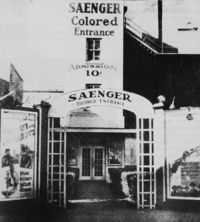Difference between revisions of "Segregation"
| Line 1: | Line 1: | ||
| + | [[Image:SaengerColoredEntrance.jpg|thumb|right|200px|The "colored entrance" of the [[Saenger Theatre]] circa 1938]] | ||
'''Segregation''' was the institutional subjugation of blacks following the [[Civil War]] and subsequent passage of the [[Wikipedia:Thirteenth Amendment to the United States Constitution|Thirteenth]] and [[Wikipedia:Fourteenth Amendment to the United States Constitution|Fourteenth Amendments]] that constitutionally abolished [[slavery]] and secured the rights of former slaves. Like other areas in the South, Pensacola was engaged in policies of legal segregation through '''Jim Crow laws''' and other means. | '''Segregation''' was the institutional subjugation of blacks following the [[Civil War]] and subsequent passage of the [[Wikipedia:Thirteenth Amendment to the United States Constitution|Thirteenth]] and [[Wikipedia:Fourteenth Amendment to the United States Constitution|Fourteenth Amendments]] that constitutionally abolished [[slavery]] and secured the rights of former slaves. Like other areas in the South, Pensacola was engaged in policies of legal segregation through '''Jim Crow laws''' and other means. | ||
Revision as of 16:59, 30 November 2008

Segregation was the institutional subjugation of blacks following the Civil War and subsequent passage of the Thirteenth and Fourteenth Amendments that constitutionally abolished slavery and secured the rights of former slaves. Like other areas in the South, Pensacola was engaged in policies of legal segregation through Jim Crow laws and other means.
Background
The origins of institutionalized segregation may be traced to the contentious 1876 election of president Rutherford B. Hayes, who ordered the withdrawal of federal troops from the South, effectively ending the Reconstruction period.
Pensacola played a pivotal role in the so-called Compromise of 1877 that delivered Florida's electoral votes (and thereby the election) to Hayes. One of the Florida's electors for Hayes, Pensacolian Frederick C. Humphreys, faced objections by the Democrats that he was constitutionally ineligible to cast a vote because he also held a federal office as shipping commissioner of the Port of Pensacola. Humphreys was able to provide proof that he had resigned from the shipping position a month before the election, and with the matter resolved, "it was such as to give all but absolute assurance that the next President will be Rutherford B. Hayes."[1]
Reconstruction was seen by many white Southerners as an affront to their regional sovereignty, an attitude that would endure for decades; William Tyler, Superintendent of Public Instruction in 1930, wrote praising "the overthrow of the carpetbag governments … after which the South was permitted to continue its own reconstruction policies."[2]
Prior to the end of Reconstruction and shortly thereafter, African-Americans had enjoyed relative success in Pensacola. Individuals of color, like Salvador Pons and Zebulon Elijah, had been elected to public office.
Streetcar segregation
In 1905, John Campbell Avery, State Representative for Pensacola, introduced a bill providing for the segregation of streetcars. Pensacola's black population responded immediately to the bill (which the legislature would pass unanimously) by boycotting the streetcar system. A report was sent to streetcar parent company Stone & Webster saying, "In Pensacola 90% of the negroes have stopped riding even though the company has not issued an order or intimated anything as to what they intend to do. The negroes have appointed Committees who meet negroes visiting their city at the train and present each one with a button to be worn in the lapel of the coat. This button bears the single word WALK."[3] Some African-Americans rode the streetcars despite the boycott, but according to the Pensacola Journal, "in each case when they are seen by persons of their own race they are subjected to taunts and cries of 'Jim Crow.'"[3]
The Florida Supreme Court (in Florida v. Patterson) struck down the Avery law a month after its passage, after which the Pensacola Journal noted, "The negroes began to ride early and it was noticeable that they almost invariably occupied the front seats."[3] However, segregation was soon reinstituted when municipalities passed ordinances using modified Avery language; in Pensacola, it was sponsored by the Chamber of Commerce. L. B. Crooms was jailed for violating the streetcar laws, and in the 1906 cases Crooms v. Schad and Patterson v. Taylor these new segregation laws were upheld as constitutional.[4]
Images
1909 ad in The Pensacolian for Puritan Laundry, touting itself as "the first and only Laundry in the City for White People Only."
References
- ↑ "The Electoral Tribunal." New York Times, February 8, 1877.
- ↑ H. Clay Armstrong, editor. History of Escambia County. St. Augstine: The Record Company, 1930.
- ↑ 3.0 3.1 3.2 Paul Ortiz. Emancipation Betrayed: The Hidden History of Black Organizing and White Violence in Florida from Reconstruction to the Bloody Election of 1920. University of California Press, 2005.
- ↑ Shira Levine. "'To Maintain Our Self-Respect': The Jacksonville Challenge to Segregated Street Cars and the Meaning of Equality, 1900-1906."
